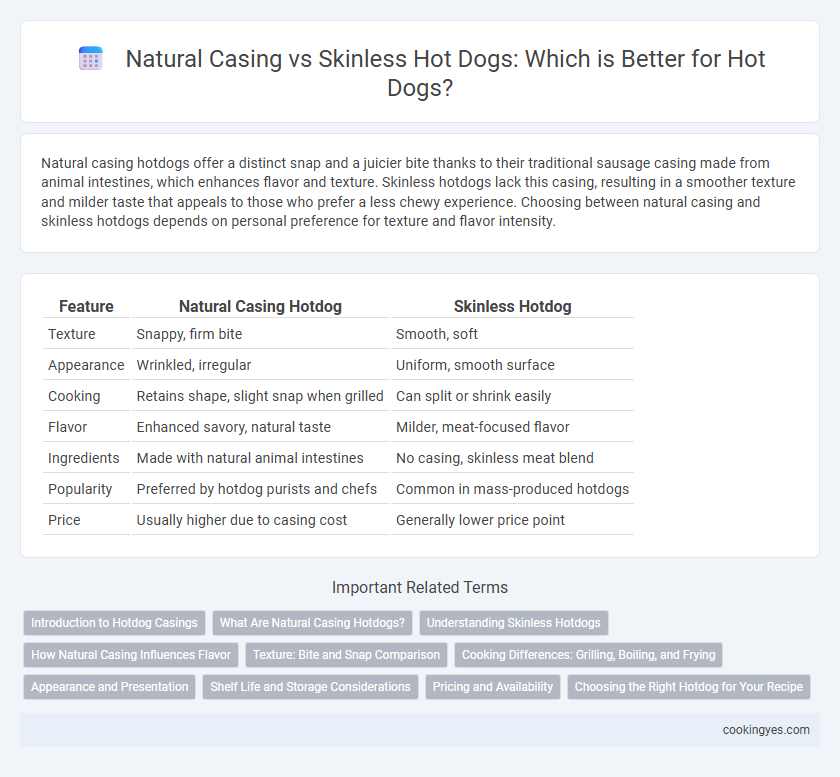Natural casing hotdogs offer a distinct snap and a juicier bite thanks to their traditional sausage casing made from animal intestines, which enhances flavor and texture. Skinless hotdogs lack this casing, resulting in a smoother texture and milder taste that appeals to those who prefer a less chewy experience. Choosing between natural casing and skinless hotdogs depends on personal preference for texture and flavor intensity.
Table of Comparison
| Feature | Natural Casing Hotdog | Skinless Hotdog |
|---|---|---|
| Texture | Snappy, firm bite | Smooth, soft |
| Appearance | Wrinkled, irregular | Uniform, smooth surface |
| Cooking | Retains shape, slight snap when grilled | Can split or shrink easily |
| Flavor | Enhanced savory, natural taste | Milder, meat-focused flavor |
| Ingredients | Made with natural animal intestines | No casing, skinless meat blend |
| Popularity | Preferred by hotdog purists and chefs | Common in mass-produced hotdogs |
| Price | Usually higher due to casing cost | Generally lower price point |
Introduction to Hotdog Casings
Hotdog casings significantly influence the texture and flavor of the final product, with natural casings made from animal intestines offering a distinctive snap and a more traditional eating experience. Skinless hotdogs, often encased in collagen or cellulose, provide a uniform shape and smoother bite, ideal for mass production and consistent quality. Understanding the differences between natural and skinless casings helps manufacturers and consumers select the best option based on preference and cooking method.
What Are Natural Casing Hotdogs?
Natural casing hotdogs are made using the cleaned intestines of animals, typically hogs, sheep, or cattle, which create a distinctive snap when bitten into. This casing is edible, biodegradable, and contributes to the traditional texture and flavor that many hotdog enthusiasts prefer. Unlike skinless hotdogs, natural casing versions maintain their shape and juiciness while offering a more authentic eating experience.
Understanding Skinless Hotdogs
Skinless hotdogs offer a smoother texture compared to natural casing hotdogs, providing a uniform bite that many consumers prefer for their convenience and consistent flavor. Unlike natural casing hotdogs, which use edible animal intestines for a characteristic snap and enhanced juiciness, skinless varieties are made by removing the casing after cooking or using collagen casings that are peeled off. Skinless hotdogs are often favored in mass production due to their ease of processing, longer shelf life, and adaptability to various recipes without the chewy bite of natural casings.
How Natural Casing Influences Flavor
Natural casing hotdogs, made from animal intestines, deliver a distinct snap and enhanced juiciness that significantly elevates the overall flavor experience. The porous texture allows smoke and seasoning to penetrate more deeply during cooking, imparting a richer, more complex taste compared to skinless hotdogs. This natural barrier also retains moisture better, resulting in a juicier bite with a robust, authentic meat flavor highly prized by connoisseurs.
Texture: Bite and Snap Comparison
Natural casing hotdogs provide a distinctive snap and firm bite due to the collagen casing that expands and cracks when cooked, enhancing the eating experience. Skinless hotdogs, lacking this outer layer, offer a softer, smoother texture with a uniform bite, appealing to those who prefer a less chewy mouthfeel. The choice between natural casing and skinless directly influences the texture profile, making natural casing ideal for lovers of a crisp snap and skinless preferred for tenderness.
Cooking Differences: Grilling, Boiling, and Frying
Natural casing hotdogs offer a distinct snap and char when grilled, enhancing the flavor and texture, while skinless hotdogs tend to cook more evenly without the snap but can become softer when grilled. Boiling skinless hotdogs ensures consistent moisture and tenderness, whereas natural casing hotdogs may retain more juiciness but risk casing burst if boiled too long. Frying skinless hotdogs allows for a uniform golden-brown exterior, while natural casing hotdogs provide a crispier bite and deeper caramelization due to the casing's interaction with high heat.
Appearance and Presentation
Natural casing hotdogs offer a distinctive, slightly wrinkled appearance with a snap when bitten, enhancing the overall presentation and providing a more authentic, artisanal look. Skinless hotdogs have a smooth, uniform exterior that appeals to those seeking a clean, consistent shape ideal for mass production or uniform plating. The choice between natural casing and skinless directly impacts visual appeal and can influence customer perception of quality and texture.
Shelf Life and Storage Considerations
Natural casing hotdogs, made from animal intestines, typically have a shorter shelf life due to their permeability to air and moisture, requiring refrigeration and consumption within a few days after opening to maintain freshness. Skinless hotdogs, encased in synthetic or collagen casings that are removed post-production, generally offer a longer shelf life with better protection against bacteria and mold during storage. Proper vacuum sealing and consistent refrigeration extend the shelf life of both types, but natural casing products demand stricter storage conditions to prevent spoilage.
Pricing and Availability
Natural casing hotdogs typically have higher pricing due to the cost of sourcing and processing animal intestines, which are less abundant and require more preparation. Skinless hotdogs are more widely available and generally budget-friendly, benefiting from streamlined manufacturing processes and readily accessible synthetic casings. Market demand for natural casing hotdogs remains niche, often linked to premium or artisanal brands, while skinless options dominate mass production and retail shelves.
Choosing the Right Hotdog for Your Recipe
Natural casing hotdogs offer a distinctive snap and enhanced flavor due to their traditional sheep or hog intestine casing, making them ideal for recipes emphasizing texture and authenticity. Skinless hotdogs provide a uniform bite and smoother texture, preferred in dishes where ease of eating and consistency are essential, such as in casseroles or sliced applications. Selecting between natural casing and skinless depends on desired mouthfeel, cooking method, and presentation in your hotdog recipe.
Natural casing vs skinless for hotdogs Infographic

 cookingyes.com
cookingyes.com